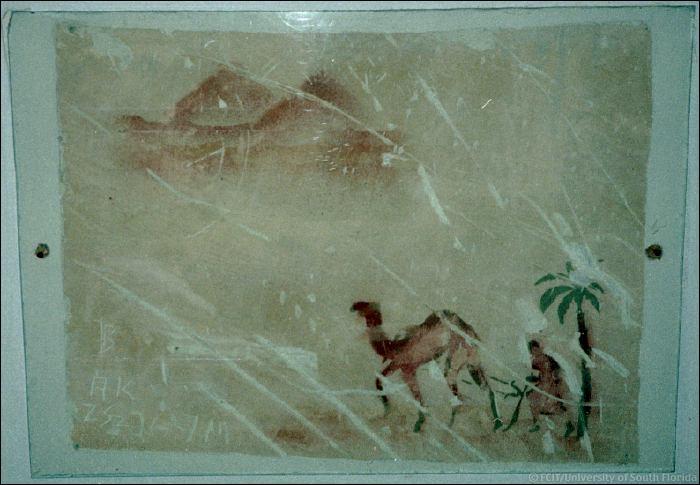Camels and Pyramids
Grade Levels: PreK through 12
Objectives:
- Identify patterns and rhythms in art and the world.
- Understand visual created motion.
- Recognize positive and negative space.
Sunshine State Standards:
- Grades K-2
- VA.A.1.2.1, 1.2.2, 1.2.3
- VA.B.1.1.1, 1.1.2, 1.1.3, 1.1.4
- VA.C.1.1.1, 1.1.2
- VA.E.1.1.1
- Grades 3-5
- VA. A.1.2.1, 1.2.2, 1.2.3,
- VA. B. 1.2.1, 1.2.2, 1.2.3,
- VA. C. 1.2.1, 1.1.2
- Grades 6-8
- VA.A.1.3.1, 1.3.2
- VA.B.1.3.1, 1.3.2, 1.3.3, 1.3.4
- VA.C.1.3.1, 1.3.2
- VA.D.1.3.2, 1.3.3
- Grades 9-12
- VA.A.1.4.1, 1.4.2
- VA.B.1.4.1, 1.4.2, 1.4.3, 1.4.4
- VA.C.1.4.1, 1.4.2
- VA.D.1.4.2, 1.4.3
Materials:
- sketch pads
- black markers
- oaktag
- scissors
- tempera paints
- brushes # 6 & 12
- sponge
- Bristol board
- reproduction of Camels and Pyramids (See resources below.)
Procedure:
Unit Study: Create a composition using repeated motifs with motion.
Day One
Share Camels and Pyramids with the class. Explain the origin of the painting in an age-apropriate manner. At the secondary level this should include a discussion of creating art under the difficult conditions of a concentration camp. Mention that the same set of stencils was used to create variations of the theme throughout a stairwell.
Create a motif conducive to repeat applications.
Trace motif onto oaktag.
Day Two
Cut motif.
Place onto bristol board.
Sponge or brush paint over motif.
Let paint dry before carefully lifting motif off from the bristol board.
Repeat procedure until a desired pattern is achieved.
Day Three
- Draw a design onto the motif that can be repeated, e.g., a slanted line, or a wiggly line. Uuse random, regular, alternating, flowing, and progressive rhythms.
- Cut design away from motif, creating the second layer of the stencil.
- Lay over painted motif.
- Sponge or brush paint the stencil over the first design to create a rhythm of motion.
Vocabulary and Definitions:
Motif - 2-dimensional unit that is repeated in a visual rhythm.
Pattern - 2-dimensional design element that repeats a motif, and or a texture, evenly spaced, decorative and repetitive.
Rhythm - one of the principles of design that creates the illusion of movement by repeating a design. Visual rhythm is created by repeating positive and negative spaces. Types of rhythm: random, regular, alternating, flowing, and progressive.
Assessment:
Mount students' work on a presentation board.
Arange a gallery for the elementary school children.
Discuss visual motion effectiveness
Resources:

Camels and pyramids wall painting from block 14 in Auschwitz. The painting was done using stencils. A number of variations of this theme using the same set of stencils decorates a stairwell.
![]()
A Teacher's Guide to the Holocaust
Produced by the Florida Center for Instructional Technology,
College of Education, University of South Florida © 1997-2013.